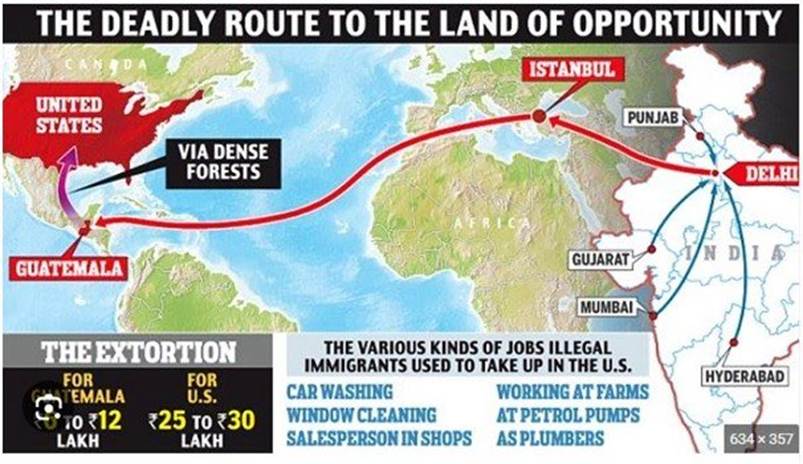Why in News
- On October 26, 2025, 50 men from Haryana (aged 25–40) were deported from the United States after being caught for illegal entry and stay via the “Dunki route.”
- They had paid hefty sums (₹25–60 lakh each) to human traffickers promising entry into the U.S. through Latin America.
- The deportation is part of a U.S. crackdown on irregular migrants, under which ~2,500 Indians have been deported since January 2023.
Relevance
- GS-2 (Governance, International Relations): Human trafficking, migration diplomacy, India–U.S. bilateral cooperation.
- GS-3 (Internal Security): Transnational crime, money laundering, illegal migration networks.
- GS-1 (Society): Rural distress, aspiration-driven migration, demographic pressures.

What is the ‘Dunki Route’?
- The “Dunki route” refers to illegal backdoor migration routes used by Indians to reach Western countries—especially the U.S., Canada, and Europe.
- The route typically passes through South America (Brazil, Ecuador, Guatemala, Mexico) and involves crossing dangerous terrains to enter the U.S. illegally.
- The term “Dunki” (Punjabi slang) derives from “donkey” — implying an underground, risky, and unapproved method of travel.
Key Facts from the Current Incident
- Financial loss: Each migrant spent between ₹29–58 lakh, selling land or taking high-interest loans.
- Journey duration: 60–120 days via South America.
- Arrests: Many detained in Georgia and Texas, jailed for 10–14 months before deportation.
- Deportation logistics: Flights operated under U.S. Immigration and Customs Enforcement (ICE) coordination.
National Scale of the Issue
- MEA data (Jan 2023–Oct 2025): ~2,500 Indians deported or repatriated from the U.S.
- States most affected: Punjab, Haryana, Gujarat, Telangana, Andhra Pradesh.
- Previous major deportation: Feb 5, 2025 — U.S. Air Force C-17 flight with 104 Indians landed in Amritsar, the longest deportation flight in U.S. history.
- India ranks among the top 5 source countries for irregular migrants intercepted at the U.S.–Mexico border.
Economic and Social Drivers
- Push Factors (India):
- Agrarian distress and rural unemployment in North Indian states.
- Aspirations for better earnings and social mobility abroad.
- Social prestige associated with foreign migration in Punjab–Haryana belt.
- Weak local job opportunities for educated youth.
- Pull Factors (Destination Countries):
- Labour demand in U.S. service and agriculture sectors.
- Smuggler networks offering “guaranteed entry” packages.
- Circulation of social media success stories of those who settled illegally.
The Human Trafficking and Agent Nexus
- Operated by interconnected networks spanning India, Latin America, and U.S.–Mexico border states.
- Payment model: Agents take partial advance in India; balance on “arrival.”
- False promises: Legal work permits, safe passage, or “political asylum.”
- Criminality: Violates the Immoral Traffic (Prevention) Act, 1956, and Foreigners Act, 1946.
- Risk factors:
- Exposure to robbery, extortion, sexual exploitation, and even death.
- No legal protection or recourse abroad.
U.S. Policy Context
- U.S. Immigration Enforcement: Since 2022, tightened asylum and border-entry policies under Title 8 deportations (post-Title 42 repeal).
- Bilateral cooperation: India and U.S. have agreed to streamline repatriations and combat illegal human trafficking networks.
- Deportees are flown back under ICE Air Operations, with coordination from MEA & Indian missions.
Legal and Diplomatic Aspects
- India’s stance: Zero tolerance toward illegal migration but emphasizes humane treatment of deportees.
- MEA & MHA coordinate with Interpol and U.S. Homeland Security to identify trafficking rackets.
- Embassies facilitate verification, travel documents, and safe return.
- State police & CID investigate local agents under Sections 370 & 420 IPC (Trafficking & Cheating).
Wider National Implications
- Highlights India’s irregular migration crisis, with thousands stranded or jailed abroad.
- Brain drain risk: Educated youth leaving rural India through illegal means due to lack of quality employment.
- Debt crisis: Families forced into bankruptcy after paying ₹30–60 lakh to agents.
- Governance challenge: Need for integration of deportees and rehabilitation schemes at the district level.
Global Context and Parallels
| Country/Region | Comparable Trend | Policy Response |
| Mexico–Central America | “Coyote” networks smuggling Latin Americans to U.S. | U.S. assistance programs, regional migration compacts |
| North Africa–Europe | Illegal crossings from Libya to Italy/Spain | EU–Africa Migration Partnership; strict maritime border control |
| Philippines | Irregular migration via Gulf states | Stringent licensing of recruitment agencies |
| Bangladesh–Malaysia | Human trafficking by sea routes | Joint task forces and rehabilitation policies |
Lesson: Global responses combine law enforcement, safe migration awareness, and local job creation.
Government and Policy Response (India)
- MEA Measures:
- Crackdown on fake travel agents through passport verification & police NOCs.
- Awareness drives via embassies and state governments.
- MHA & State Police:
- Haryana CID tracking 100+ suspected human smuggling agents.
- FIRs under IPC 420, 370, and Passport Act violations.
- Skill Development Link:
- Integration with PM Vishwakarma Yojana, Skill India Mission to generate domestic employment.
- Migration Governance Framework:
- Strengthen e-Migrate portal (currently for Gulf migration) to cover Western destinations.
- Introduce a National Anti-Human Smuggling Policy.
Ethical and Societal Dimensions
- Reflects moral hazard where desperation overrides legality.
- Raises questions on agents’ accountability, state regulation, and society’s glorification of foreign success.
- Deportees face social stigma, making reintegration difficult.
Long-term Way Forward
- Preventive:
- Awareness campaigns in rural belts on risks of “Dunki” migration.
- Stricter licensing and monitoring of travel and placement agents.
- Data-sharing MoUs with the U.S., Canada, Mexico, and Brazil.
- Curative:
- Rehabilitation schemes for deportees (skill training, debt relief).
- Legal aid and compensation for victims of trafficking.
- Collaboration with UNODC & IOM for safe migration corridors.
- Structural:
- Boost rural livelihoods under PMEGP, NRLM, Agri Value Chains.
- Promote legal migration routes through bilateral labour agreements.



